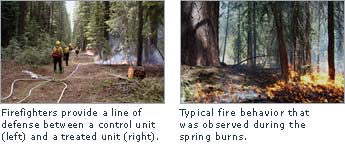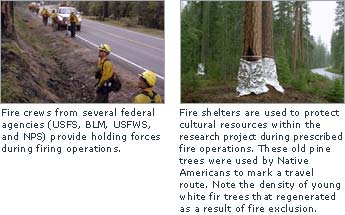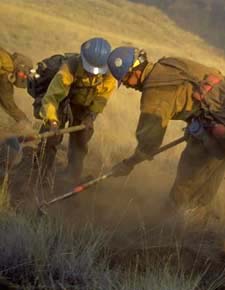Crater Lake National Park: Managers and Scientists Collaborate to Create Fire-safe Forests at Crater Lake National Park
2002
Fire and Aviation Management
National Park Service Website
U.S. Department of the Interior
National Fire Plan research dollars are used to develop best available science to reduce hazardous fuels and restore fire-adapted ecosystems at Crater Lake National Park, Oregon.
Problem Statement
Determining when to burn to achieve desired outcomes is key to any successful prescribed fire management program. The rationale for selecting burn parameters must be science-based in order to predict desired outcomes. Managers today know that treatments that promote firesafe forests including: removing certain types of fuels (surface, ladder, and crown), and maintaining specific ecological characteristics (such as widely-spaced fire resistant trees) are desirable. But knowing the “what” is different then knowing the “when”.
 Background According to Jim Agee, research scientist at the University of Washington’s College of Forest Resources, “Active management to restore forest ecosystems must be done with a view to the long-term consequences of short-term actions. For example, spring burning in the Pacific Northwest may be desirable because smoke disperses more easily then and control over fire intensity is easier in this moist time of year. However, in this region, it is not the natural season of burning and unintended ecological consequences may result: damage to fine roots active in the spring or disruption of ground-nesting animals. Fire is much more than a binary (present/absent) process; the whole regime must be considered.”
Background According to Jim Agee, research scientist at the University of Washington’s College of Forest Resources, “Active management to restore forest ecosystems must be done with a view to the long-term consequences of short-term actions. For example, spring burning in the Pacific Northwest may be desirable because smoke disperses more easily then and control over fire intensity is easier in this moist time of year. However, in this region, it is not the natural season of burning and unintended ecological consequences may result: damage to fine roots active in the spring or disruption of ground-nesting animals. Fire is much more than a binary (present/absent) process; the whole regime must be considered.”
Back in 1976, after more than 80 years of aggressive fire suppression, a prescribed fire program was initiated at Crater Lake National Park to restore approximately 42,500 acres of mixed-conifer forests. The objectives were to favor retention of large ponderosa pine over shade-tolerant species and to create conditions that enhance ponderosa pine regeneration. Studies were undertaken in conjunction with the prescribed burning program to examine the effects of the management-ignited fires. Unexpected mortality of large ponderosa pine occurred during the ten-year program of prescribed fires that treated more than 650 acres.
It was determined that the prescribed fires had burned too hot and too much duff was removed, thus weakening trees and increasing the probability of attack by bark beetles. Recommendations were made to conduct multiple hazard-reduction burns at lower fire intensities, rather than a single burn, and for burns to be done earlier in the spring when duff moisture was higher. There was limited information available to park managers on the effects of carrying out these recommendations, however, and prescribed burning was discontinued after 1987. The recommendations were never tested, until now.
Solving the Problem
Thanks to research funding from the Joint Fire Science Program, resource and fire staff are collaborating with scientists from the University of Washington to determine the best time to reduce hazardous fuels and restore the fire-adapted mixed-conifer forests at Crater Lake National Park. The collaborative project involves collecting research data from a series of management-ignited fires conducted on National Park Service property.
The project area consists of 200 acres divided into 24 treatment units (8 spring, 8 fall, and 8 unburned control units) in the southern portion of the park. As a typical mixed-conifer forest, it has a ponderosa pine overstory with a multi-layered white fir understory and occasional presence of other tree species (e.g. sugar pine, lodgepole pine, Shasta red fir).
The project objectives are to: quantify the effects of spring versus fall burning on standard fire response variables such as fuel consumption and understory vegetation effects under varying duff moisture conditions; and to quantify the effects of such fires on vigor and mortality of large ponderosa pine which are the most important structural element in these mixed-conifer forests.
 Post-burn data collection and analysis will continue through 2004, with initial results expected in 2003.Unit layout and line construction occurred in 2001, along with pre-burn data collection. The “spring” prescribed fires were completed during a four-day period during mid-June, 2002 and the “fall” prescribed fires were completed over a two-day period in October, 2002. All of the burns were accomplished with interagency support from the US Forest Service, Bureau of Land Management, US Fish and Wildlife Service and National Park Service.
Post-burn data collection and analysis will continue through 2004, with initial results expected in 2003.Unit layout and line construction occurred in 2001, along with pre-burn data collection. The “spring” prescribed fires were completed during a four-day period during mid-June, 2002 and the “fall” prescribed fires were completed over a two-day period in October, 2002. All of the burns were accomplished with interagency support from the US Forest Service, Bureau of Land Management, US Fish and Wildlife Service and National Park Service.
In addition to obtaining the answer to “when is the best time to apply prescribed fire to the mixed-conifer forests at Crater Lake National Park,” there are several other achievements of this collaborative effort:
A demonstration site has been established to evaluate various fuels treatment practices and their effects and to interpret these results to park visitors.
The total number of acres at risk to severe wildfire has been reduced by 194 acres.
Initial research results along with local environmental conditions are being factored into hazardous fuels treatment planning.
A program of fire research within the park has been revived after a 20-year pause.
Working together, managers and scientists are developing and using the best available science to reduce hazardous fuels and restore fire-adapted ecosystems in order to create firesafe forests at Crater Lake National Park. This collaboration was made possible through National Fire Plan funds under the direction of the Joint Fire Sciences Program.
For more information
Mary Rasmussen
Fire Ecologist
Crater Lake National Park
Phone: 541-594-3073
Mary_Rasmussen@nps.gov
Additional Reading: Agee, James K. 2002. The Fallacy of Passive Management – Managing for Firesafe Forest Reserves. Conservation Biology in Practice 3(1):18-25.
Other pages in this section
*** previous title *** --- *** next title ***


